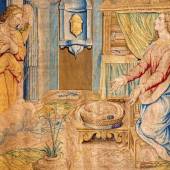Celebrating the Feast of Our Lady of Mount Carmel: A deep dive into Devotion and Tradition

The church celebrates the feast of Our Lady of Mount Carmel annually on July 16th, honoring the patroness of the Carmelite Order.
This feast, instituted around 1386, holds significant importance for Carmelites, commemorating the many favors and blessings bestowed upon them by Mother Mary, especially during the turbulent ecumenical council of 1274 when the Order faced severe threats but was preserved through Mary’s intercession.
The devotion to Our Lady of Mount Carmel is deeply intertwined with the Brown Scapular, a symbol rich in biblical significance related to clothing.
This connection echoes the gifts of clothing in the Bible, such as Jacob's gift to Joseph and Jonathan's coat given to David, as well as Mary's act of wrapping Jesus in swaddling clothes and St. Paul's exhortation to "put on Christ." These instances highlight clothing as a metaphor for spiritual salvation.
In baptism, we receive a new white robe symbolizing new life in Christ. Similarly, wearing the Brown Scapular signifies a desire to emulate Mary's virtues, spiritually adorning ourselves as brides adorned with virtues.
Its widespread popularity among Catholics underscores its role as a sign of belonging to Mary and a pledge of her maternal protection in this life and the next.
According to Fr. Kavanaugh, a translator of Carmelite saints' works, the Brown Scapular represents belonging to the Carmelite family, consecration to and trust in Mary, and an incentive to imitate her virtues, especially humility, chastity, and prayerfulness.
Although the Church has made no official pronouncements regarding St. Simon Stock’s vision or specific rules and rewards associated with the scapular, it remains a cherished sacramental, recommended alongside the rosary by successive Popes and church documents.
Pope Pius XII likened wearing the scapular to the bravery of knights in the 13th century, who found courage and confidence under their lady's gaze.
Pope Saint John Paul II also expressed his devotion to the scapular, underscoring its enduring significance within the Carmelite tradition.
Enrollment in the scapular typically occurs on the day of the First Holy Communion and can be alternatively replaced by a medal featuring the Sacred Heart of Jesus and Mary.
The Church provides a special rite for blessing and enrollment, usually conducted within a community celebration by priests or deacons.
In the Carmelite tradition, the scapular is revered as the "Armour of God." Saints and blessed members of the Carmelite family have dedicated their lives to the deep spirituality symbolized by the habit of the Virgin Mother Mary, whom they lovingly call "Our Sister."
St. Teresa of Avila, a Doctor of the Church and Carmelite reformer, wrote in "The Interior Castle": "I trust in the merits of the Son of God and of this Virgin Mother, whose habit I wear humbly. And you, my children, who also wear it, give thanks to God for becoming true children of this Mother, because she is such a great Mother... Imitate her and realize how fortunate we are to have such a great Patron" (Mansion 3, 1.3).
St. Thérèse of Lisieux, another Doctor of the Church, felt watched over by the Mother at the feet of Our Lady of Victory in Paris: "I understood that she was watching over me, that I was truly her child. Therefore, I could do nothing else but call her Mamma, even more tenderly than Mother. I prayed to her to always watch over me and to help me quickly achieve my dreams, hiding me in the shadow of her virgin mantle."
Saint Teresa Benedicta of the Cross, a Discalced Carmelite martyr and patroness of Europe, wrote two years before she died in a Nazi gas chamber: "You have clothed me with the vestments of salvation (Isaiah 61:10). This is our prayer for the feast of the Queen of Carmel, our Order's greatest celebration.
We call ourselves her sisters and daughters, receiving her special habit of salvation... As a sign of her motherly favor, she gives us her holy Scapular, which is like God's armour."
Blessed Isidore Bakanja, a humble laborer from Congo, was baptized at 21 by the Trappist Fathers of Belgium, who gave him a Scapular of Mount Carmel and a Rosary.
Known for teaching his faith, Isidore courageously refused to renounce his faith or remove the scapular when pressured by an atheist Belgian official.
He was whipped to death but forgave his persecutor and prayed for him. In 1994, Blessed John Paul II declared him "Blessed," praising his devotion to the Rosary and the Scapular of the Virgin of Carmel.
Wearing the scapular is not a magical charm or a guarantee of salvation but a visible sign of love for Mary, trust in her intercession, and a commitment to live according to Christ's teachings. It encourages openness to God's will and recognition of His presence in all aspects of life.
Devotions to saints and Mother Mary are important in the Church, guiding us closer to Jesus by emulating their virtues. Understanding the deeper meaning of these devotions helps strengthen our relationship with Christ.
Radio Veritas Asia (RVA), a media platform of the Catholic Church, aims to share Christ. RVA started in 1969 as a continental Catholic radio station to serve Asian countries in their respective local language, thus earning the tag “the Voice of Asian Christianity.” Responding to the emerging context, RVA embraced media platforms to connect with the global Asian audience via its 21 language websites and various social media platforms.














